Submitted:
31 July 2023
Posted:
02 August 2023
You are already at the latest version
Abstract
Keywords:
1. Introduction
2. Materials and Methods
2.1. Locating Contaminated Sites
2.2. Demographics Data Collection and Sources of IEP Data
2.3. GIS Data Collection Sources: Toxics Sites, School District Polygons, Housing Characteristics
2.4. Embedding Contaminated Sites with School District
2.5. Calculating Toxic Score
2.6. GIS Tools and Data Analysis
3. Results
3.1. School Based Demographics, IEP Data and Associated Contaminated Sites
3.2. Contaminated Sites
3.3. Toxic Scores and IEP Statistical Analysis
3.4. Demographics of Race and Poverty Proxy
3.4.1. Age by Toxic Score
3.4.2. White vs. Black Population by Toxic Score and IEP
3.4.3. Household Income and Poverty Percentage by Toxic Score
3.4.4. Education and Toxic Score
3.4.5. Free and Reduced Lunch Enrollment by Toxic Score and IEP Level
3.5. GIS Visuals on IEP, Toxic Score, and Demographics Based on School Districts
3.5.1. Toxic Score and IEP level with Poverty Percentage
3.5.3. IEP and Toxic Score with Free/Reduced Lunch in Elementary School District
4. Discussion
5. Conclusions
Author Contributions
Funding
Institutional Review Board Statement
Informed Consent Statement
Data Availability Statement
Acknowledgments
Conflicts of Interest
References
- Williams, D.; Zeman, C. Case study evaluation: PIEER internship program and its impact on interns’ self-reported attitudes and behaviors regarding environmental health equity. Int. J. Sustain. High. Educ. 2021, 22, 1646–1663. [Google Scholar] [CrossRef]
- Landrigan, P.J.; Schechter, C.B.; Lipton, J.M.; Fahs, M.C.; Schwartz, J. Environmental pollutants and disease in American children: estimates of morbidity, mortality, and costs for lead poisoning, asthma, cancer, and developmental disabilities. Environ. Health Perspect. 2002, 110, 721–728. [Google Scholar] [CrossRef] [PubMed]
- Mohai, P.; Lantz, P.M.; Morenoff, J.; House, J.S.; Mero, R.P. Racial and Socioeconomic Disparities in Residential Proximity to Polluting Industrial Facilities: Evidence from the Americans' Changing Lives Study. Am. J. Public Health 2009, 99, S649–S656. [Google Scholar] [CrossRef] [PubMed]
- Bullard, R.D.; Johnson, G.S.; Torres, A.O. Environmental Health and Racial Equity in the United States: Building Environmentally Just, Sustainable, and Livable Communities. American Public Health Association, 2011. [Google Scholar]
- Landrigan, P.J.; Fuller, R.; Fisher, S.; Suk, W.A.; Sly, P.; Chiles, T.C.; Bose-O'Reilly, S. Pollution and children's health. Sci. Total Environ. 2019, 650, 2389–2394. [Google Scholar] [CrossRef] [PubMed]
- National Research Council Committee on Pesticides in the Diets of Infants and Children. Pesticides in the Diets of Infants and Children. In Pesticides in the Diets of Infants and Children; National Academies Press: Washington, DC, USA, 1993. [Google Scholar] [CrossRef]
- Scheuplein, R.; Charnley, G.; Dourson, M. Differential Sensitivity of Children and Adults to Chemical Toxicity: I. Biological Basis. Regul. Toxicol. Pharmacol. 2002, 35, 429–447. [Google Scholar] [CrossRef] [PubMed]
- Leonardo, T.; Yinghua, L. Reducing the Staggering Costs Of Environmental Disease In Children, Estimated At $76.6 Billion In 2008. Health Aff. 2011, 30, 863–870. [Google Scholar] [CrossRef]
- World Health Organization. Air Pollution and Child Health: Prescribing Clean Air; World Health Organization: Geneva, Switzerland, 2018. [Google Scholar]
- Vrijheid, M.; Casas, M.; Gascon, M.; Valvi, D.; Nieuwenhuijsen, M. Environmental pollutants and child health—A review of recent concerns. Int. J. Hyg. Environ. Health 2016, 219, 331–342. [Google Scholar] [CrossRef] [PubMed]
- Sly, P.D.; Flack, F. Susceptibility of Children to Environmental Pollutants. Ann. New York Acad. Sci. 2008, 1140, 163–183. [Google Scholar] [CrossRef] [PubMed]
- Beck, E. The Love Canal Tragedy. Available online: https://archive.epa.gov/epa/aboutepa/love-canal-tragedy.html (accessed on 21 July 2023).
- The Bullitt County History Museum. Valley of the Drums. Available online: https://bullittcountyhistory.org/bchistory/valleydrum.html (accessed on 21 July 2023).
- Environmental Protection Agency. A.L. TAYLOR (VALLEY OF DRUMS) BROOKS, KY Cleanup Activities. Available online: https://cumulis.epa.gov/supercpad/SiteProfiles/index.cfm?fuseaction=second.Cleanup&id=0402072#bkground (accessed on 21 July 2023).
- Environmental Protection Agency. What is Superfund. Available online: https://www.epa.gov/superfund/what-superfund (accessed on 21 July 2023).
- Environmental Protection Agency. Search Superfund Site Information. Available online: https://cumulis.epa.gov/supercpad/cursites/srchsites.cfm (accessed on 21 July 2023).
- Environmental Protection Agency. Overview of EPA's Brownfields Program. Available online: https://www.epa.gov/brownfields/overview-epas-brownfields-program (accessed on 21 July 2023).
- Environmental Protection Agency. Types of Contaminated Sites. Available online: https://19january2017snapshot.epa.gov/enforcement/types-contaminated-sites_.html (accessed on 21 July 2023).
- Environmental Protection Agency. Frequently Asked Questions. Available online: https://www.epa.gov/brownfields/frequently-asked-questions#Does%20EPA%20clean%20up%20brownfield%20sites? (accessed on 21 July 2023).
- Environmental Protection Agency. Brownfields and Public Health. Available online: https://www.epa.gov/brownfields/brownfields-and-public-health (accessed on 21 July 2023).
- Environmental Protection Agency. Common Types of Brownfields and their Contaminants. Available online: https://www.epa.gov/brownfields/common-types-brownfields-and-their-contaminants (accessed on 21 July 2023).
- Agency for Toxic Substances and Disease Registry. Public Health Statement for Arsenic. Available online: https://wwwn.cdc.gov/TSP/PHS/PHS.aspx?phsid=18&toxid=3 (accessed on 21 July 2023).
- Environmental Protection Agency. Learn About Asbestos. Available online: https://www.epa.gov/asbestos/learn-about-asbestos#effects (accessed on 21 July 2023).
- Environmental Protection Agency. Learn About Lead. Available online: https://www.epa.gov/lead/learn-about-lead#effects (accessed on 21 July 2023).
- Iowa Department of Natural Resources. Facility Explorer. Available online: https://facilityexplorer.iowadnr.gov/facilityexplorer/ (accessed on 21 July 2023).
- Python Software Foundation.<i> Python Language Reference</i>, 3.11. 26. Python Software Foundation. Python Language Reference.
- Microsoft Corporation. Microsoft Excel; Microsoft Corporation: Redmond, WA, USA, 2016. [Google Scholar]
- SAS Institute. JMP, 13.00; SAS Institute: Cary, NC, USA, 1989–2007. [Google Scholar]
- Environmental Protection Agency. In Environmental Contaminants Often Found at Brownfield Sites; 2019.
- University of Waashington. What is an Individualized Education Plan? Available online:. Available online: https://www.washington.edu/accesscomputing/what-individualized-education-plan (accessed on 21 July 2023).
- Khan, R.K.; Strand, M.A. Road Dust and It's Effect on Human Health: A literature Review. Epidemiol. Health 2018. [Google Scholar] [CrossRef] [PubMed]
- Sanborn, M.D.; Abelsohn, A.; Campbell, M.; Weir, E. Identifying and managing adverse environmental health effects: 3. Lead exposure. CMAJ Can. Med. Assoc. 2002, 166, 1287–1292. [Google Scholar]
- Liu, J.; Lewis, G. Environmental toxicity and poor cognitive outcomes in children and adults. J. Envion. Health 2014, 76, 130–138. [Google Scholar] [CrossRef]
- Hughes, M.F. Arsenic toxicity and potential mechanisms of action. Toxicol. Lett. 2002, 133, 1–16. [Google Scholar] [CrossRef] [PubMed]
- Trasande, L.; Schechter, C.B.; Haynes, K.A.; Landrigan, P.J. Mental retardation and prenatal methylmercury toxicity. Am. J. Ind. Med. 2006, 49, 153–158. [Google Scholar] [CrossRef] [PubMed]
- Chen, C. Methylmercury effects and exposures: who is at risk? National Institute of Environmental Health Sciences, 2012; Volume 120, pp. a224–a225. [Google Scholar]
- Vickers, N.J. Animal communication: when i’m calling you, will you answer too? Curr. Biol. 2017, 27, R713–R715. [Google Scholar] [CrossRef] [PubMed]
- Marya, R.; Patel, R. Inflamed: Deep Medicine and the Anatomy of Injustice. Penguin UK, 2021. [Google Scholar]
- Grigorenko, E.L.; Macomber, D.; Hart, L.; Naples, A.; Chapman, J.; Geib, C.F.; Chart, H.; Tan, M.; Wolhendler, B.; Wagner, R. Academic achievement among juvenile detainees. J. Learn. Disabil. 2015, 48, 359–368. [Google Scholar] [CrossRef] [PubMed]
- Grindal, T.; Schifter, L.A.; Schwartz, G.; Hehir, T. Racial differences in special education identification and placement: Evidence across three states. Harv. Educ. Rev. 2019, 89, 525–553. [Google Scholar] [CrossRef]
- National Center for Learning Disabilities. Significant Disproportionality in Special Education: Trends Among Black Students.
- Collier, C. Seven Steps to Separating Difference from Disability. Thousand Oaks, CA, USA, 2011. [Google Scholar] [CrossRef]
- Morgan, H. Misunderstood and mistreated: Students of color in special education. Online Submiss. 2020, 3, 71–81. [Google Scholar] [CrossRef] [PubMed]
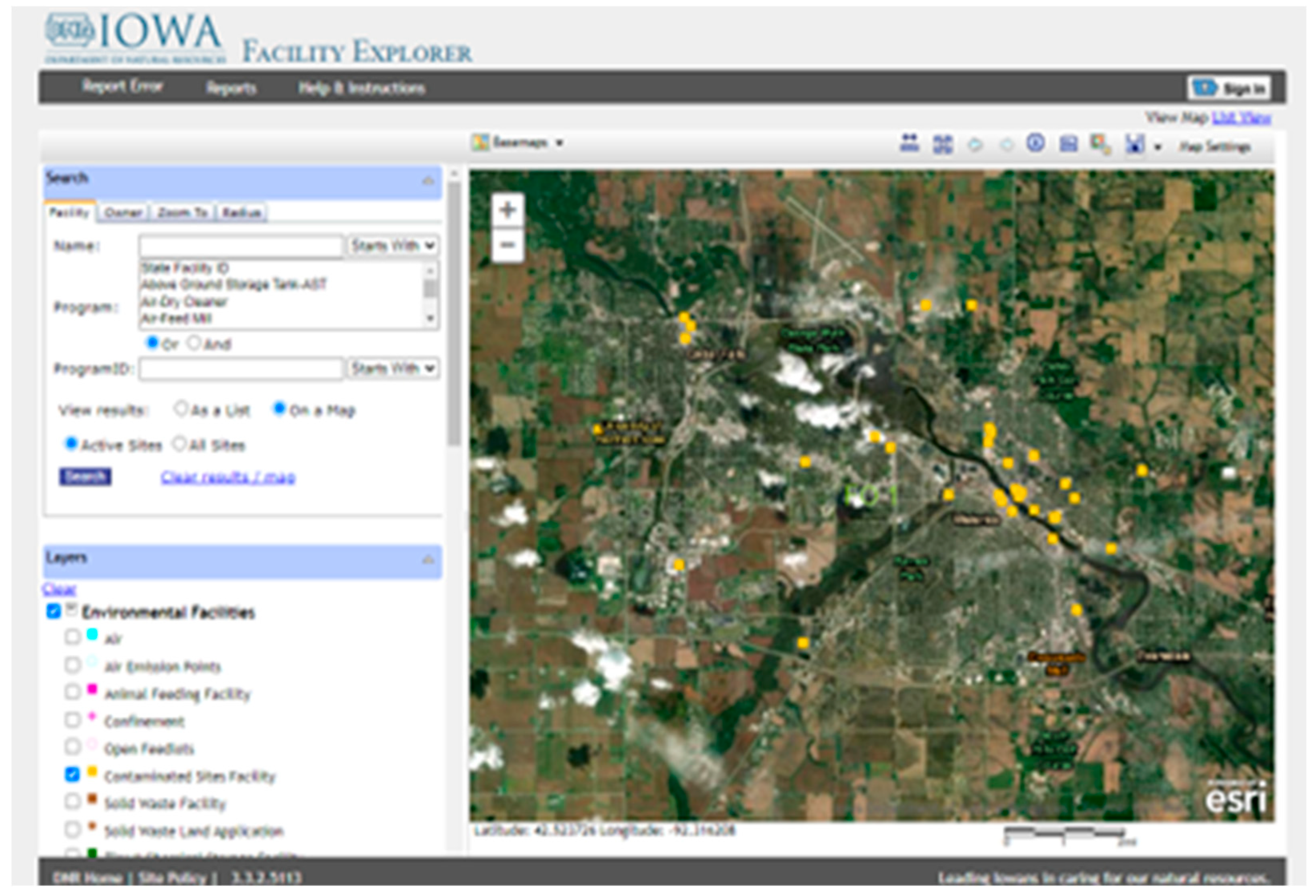
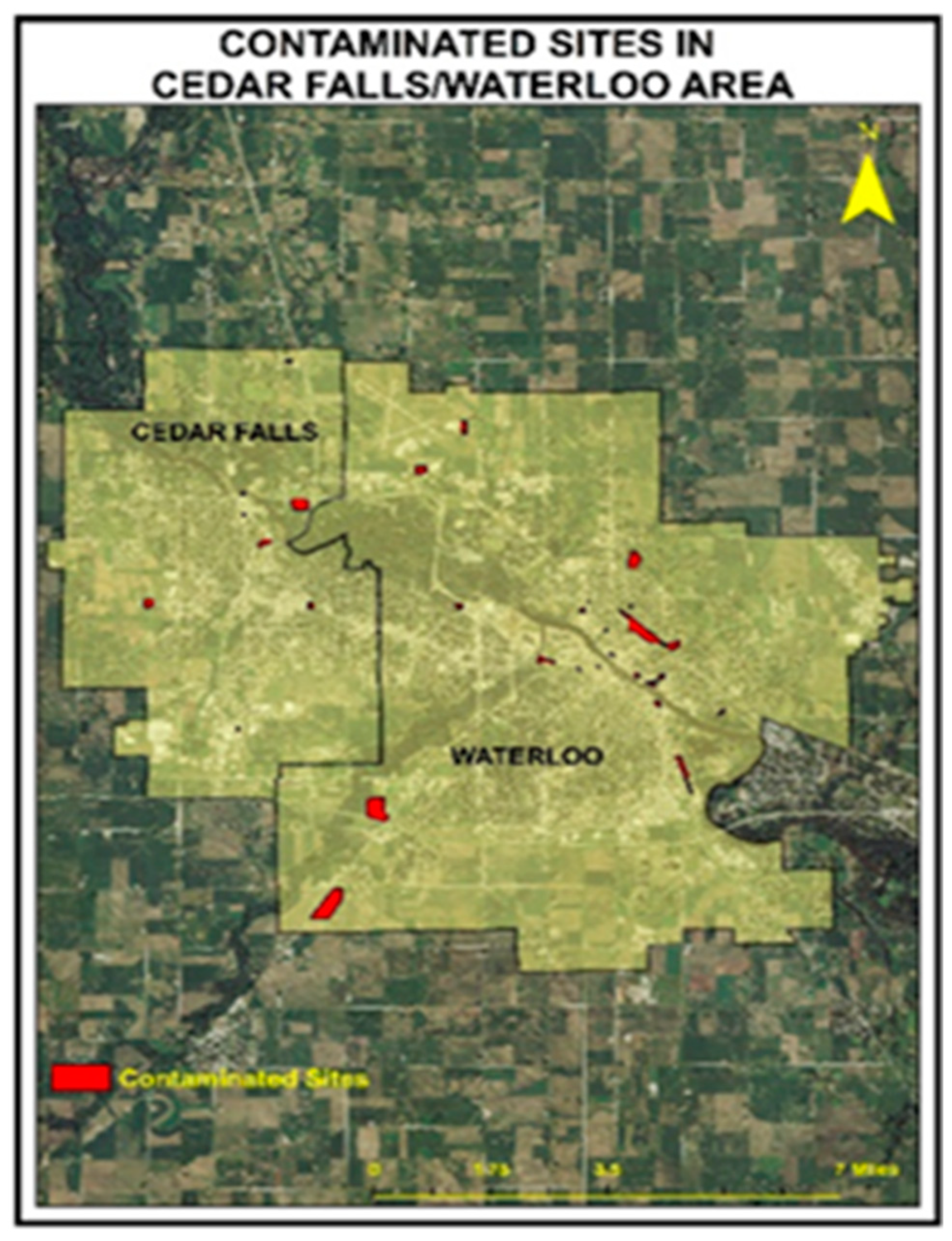
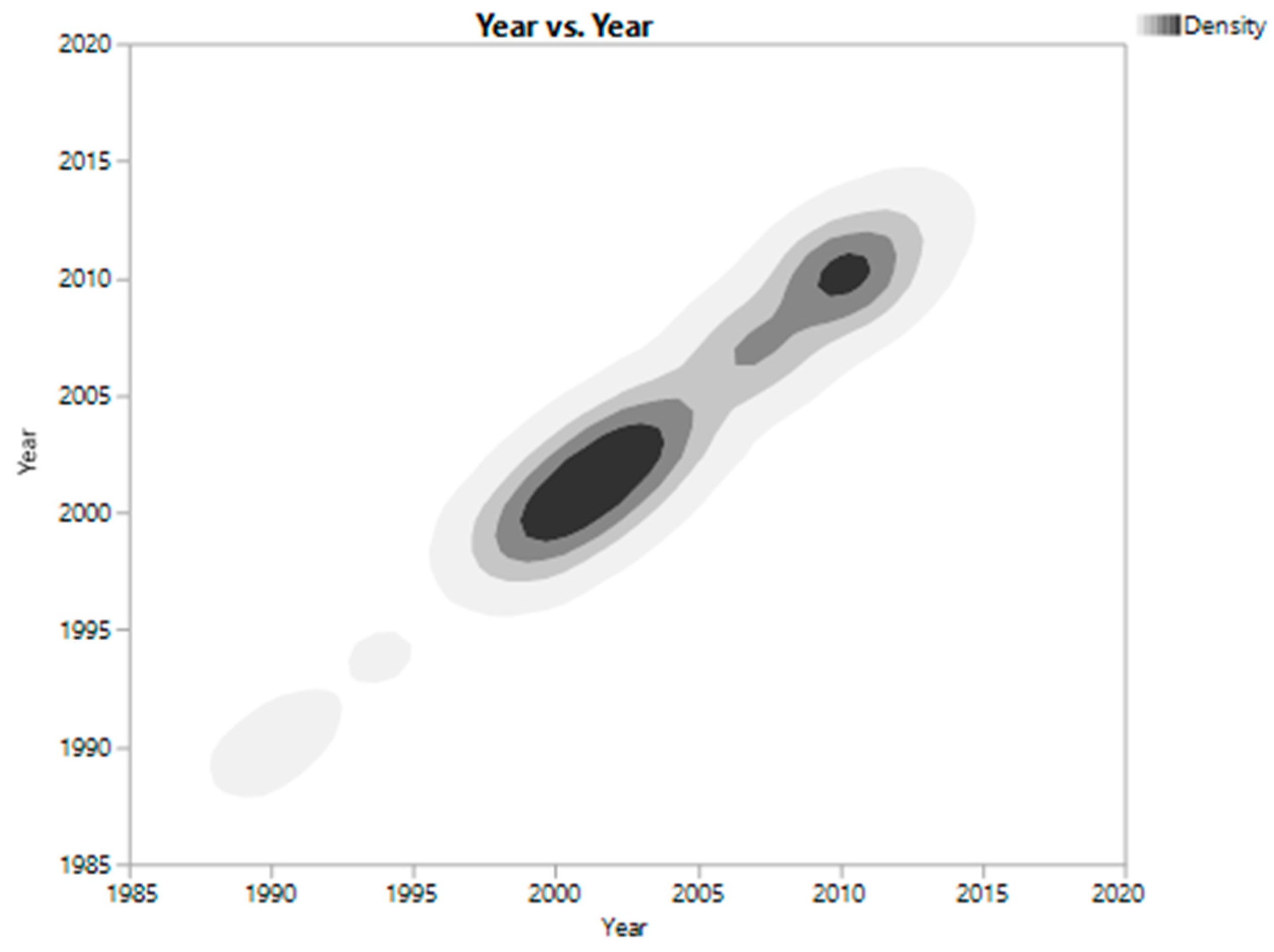
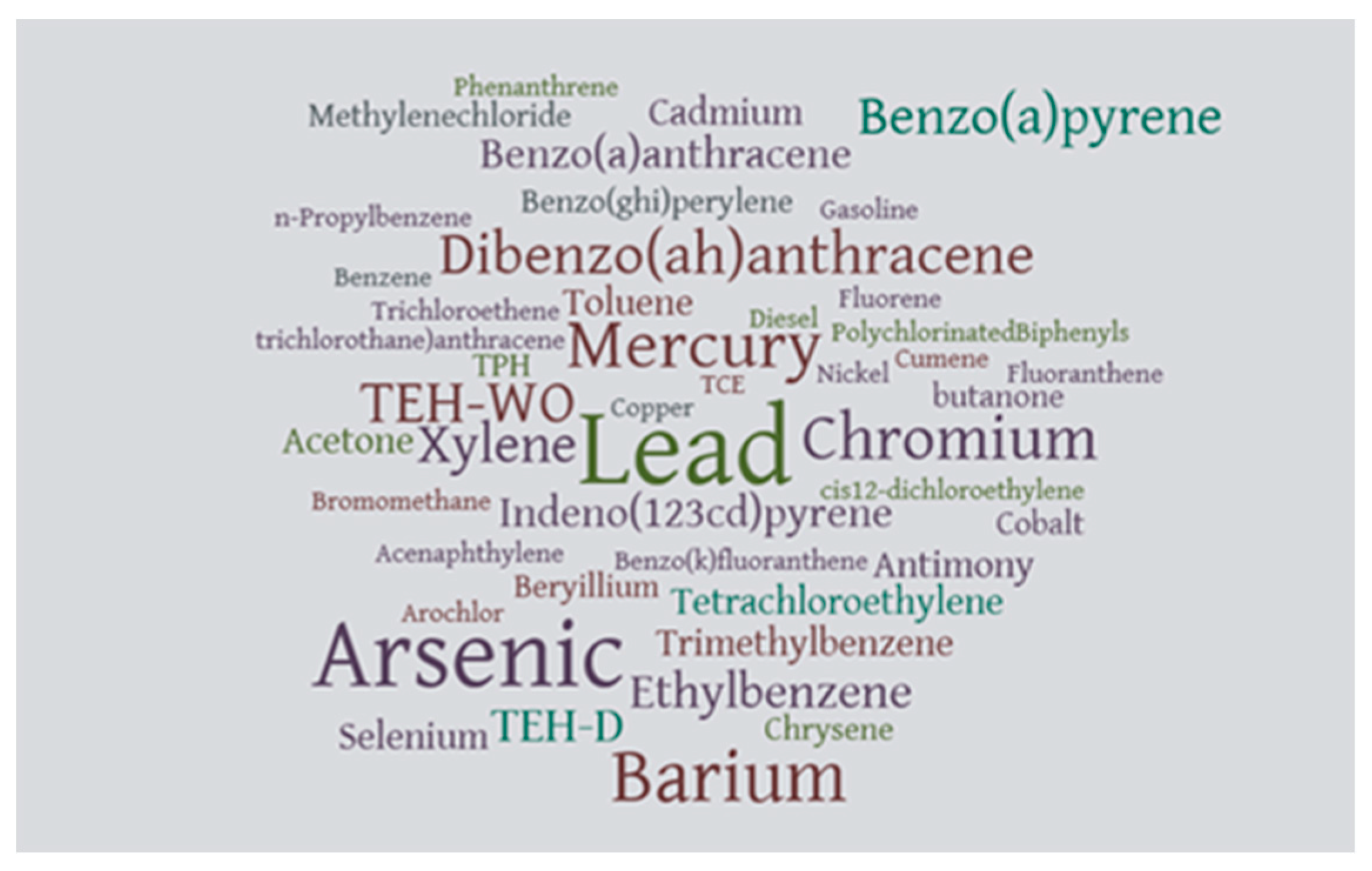
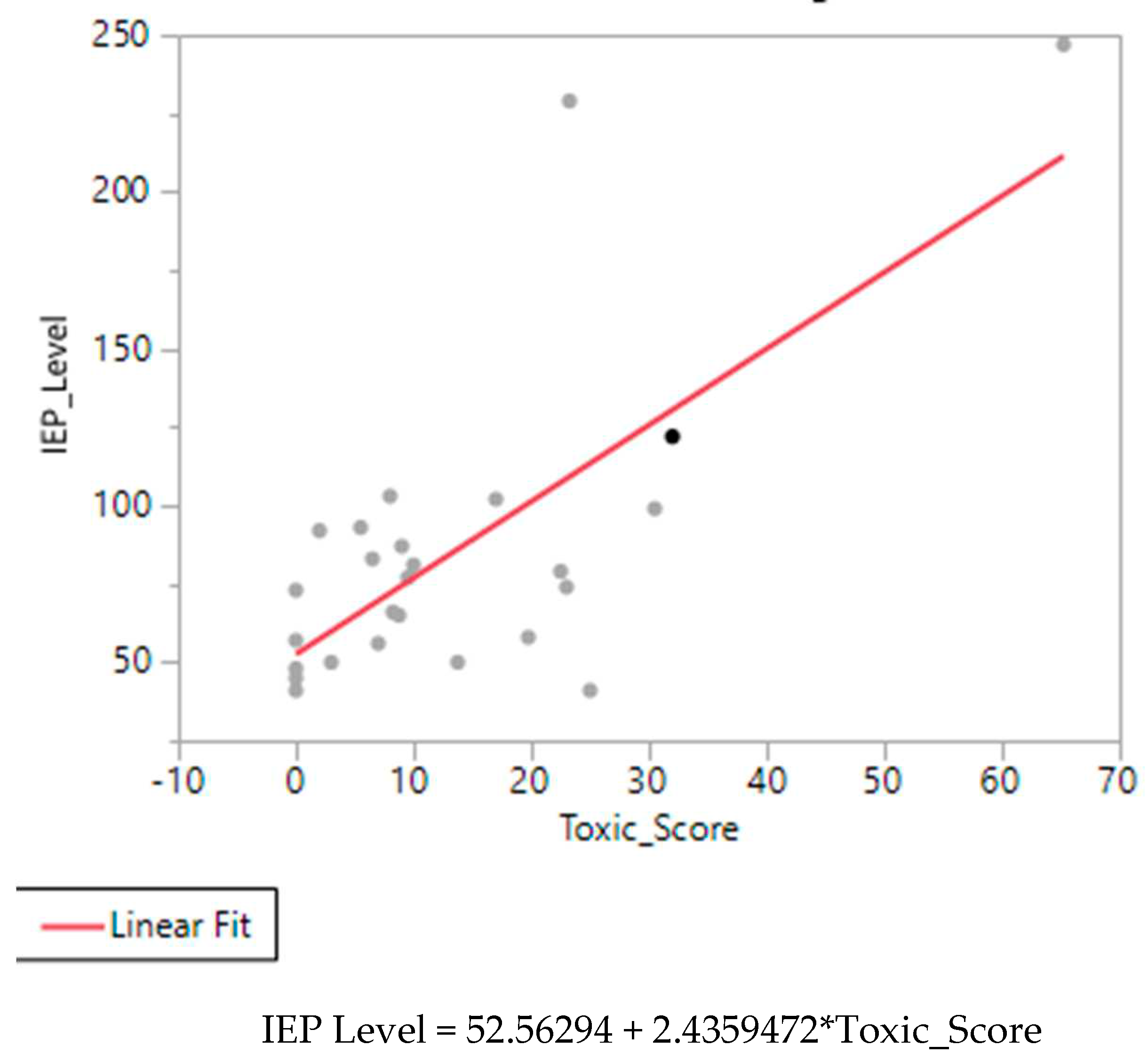
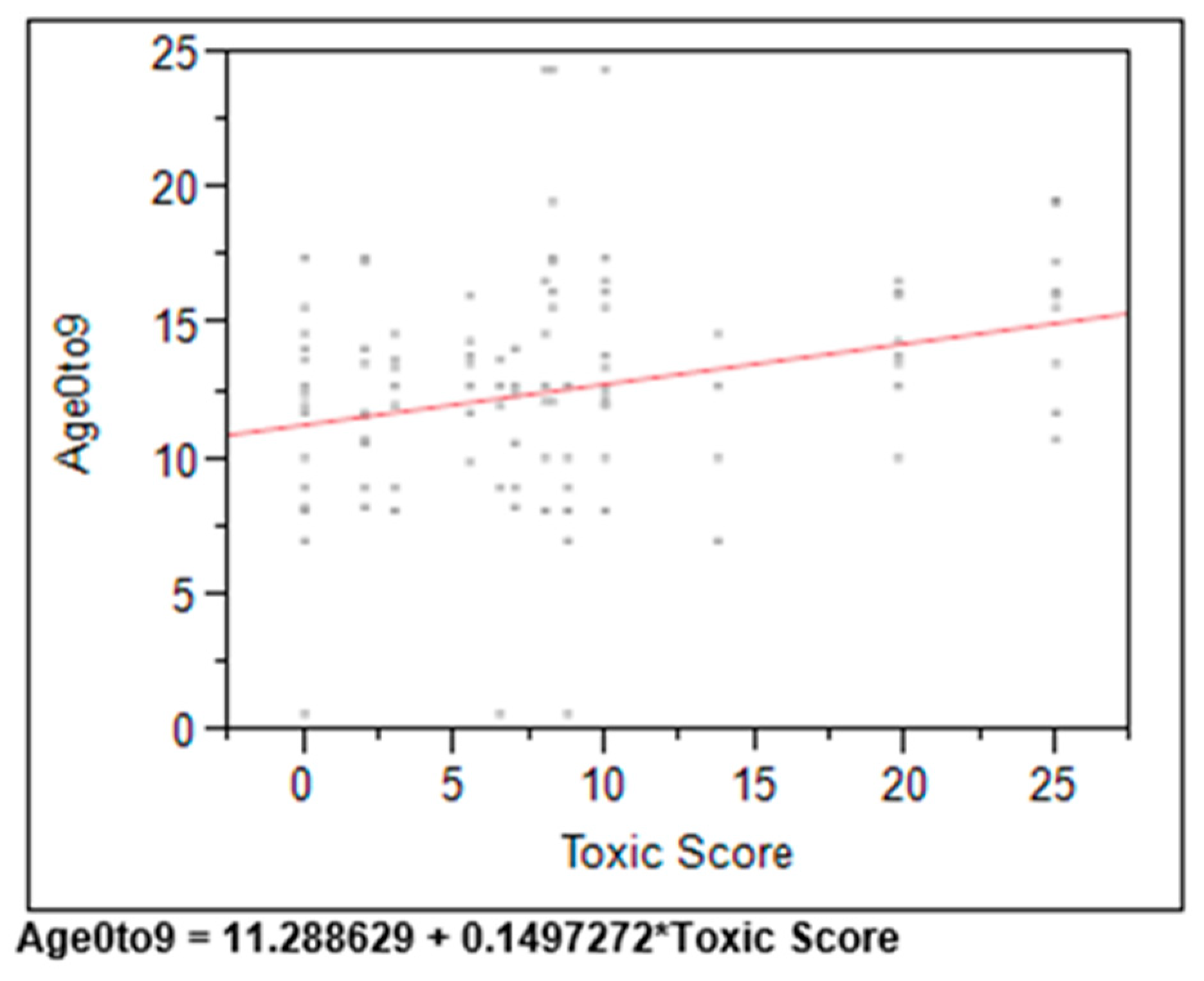
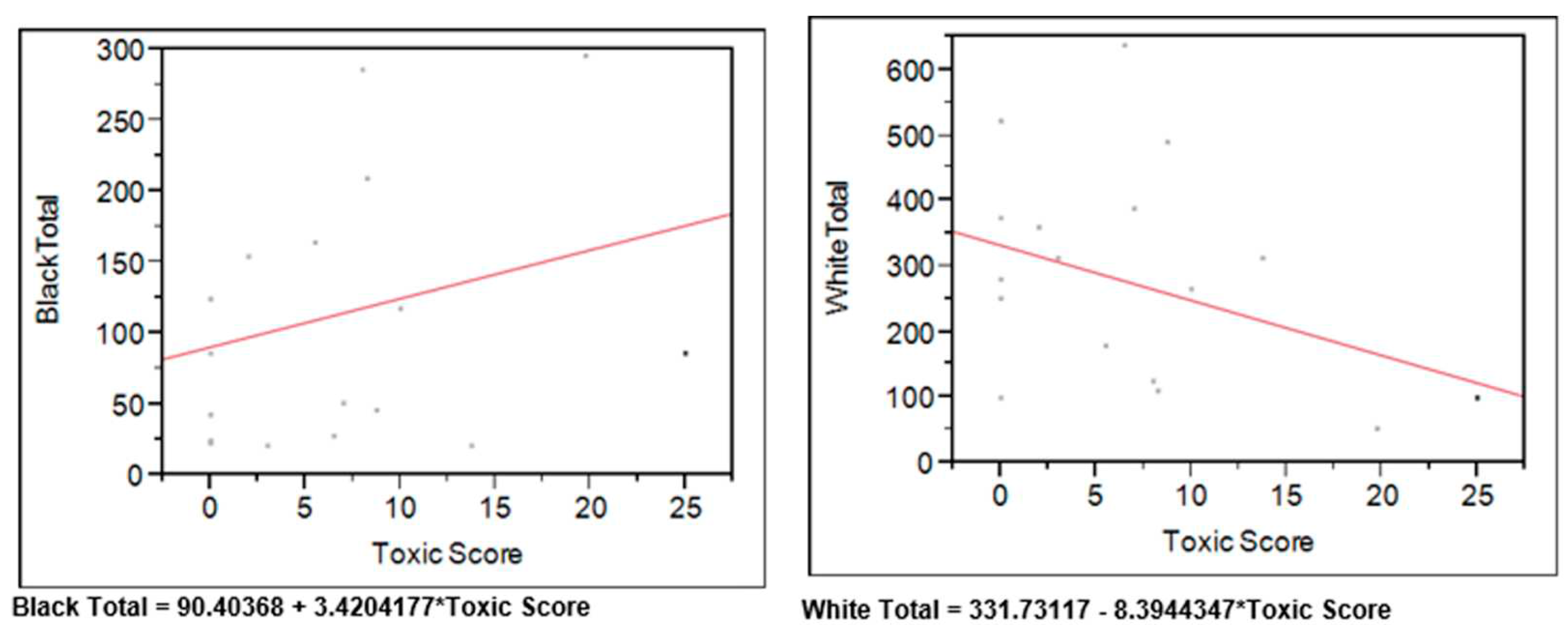
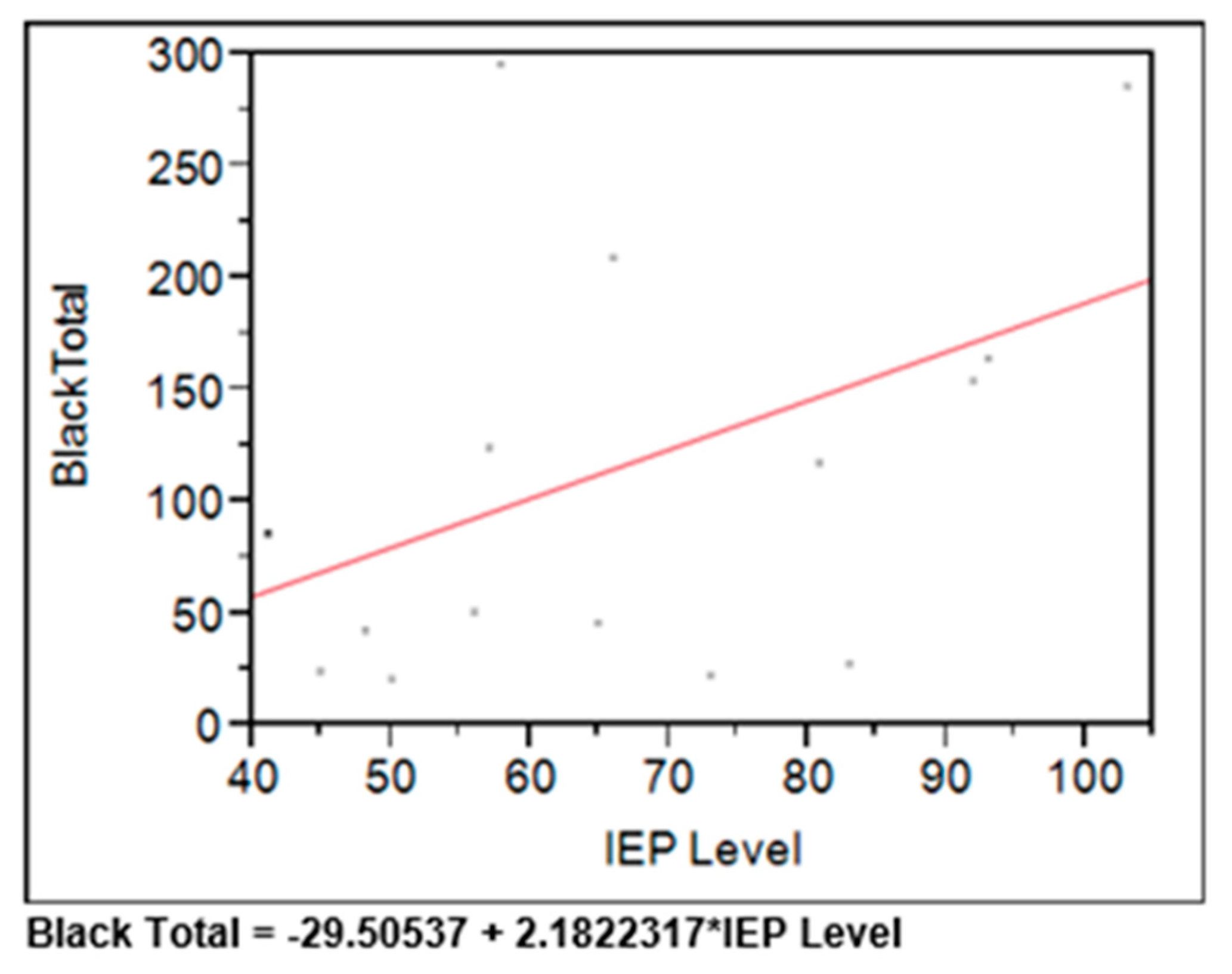
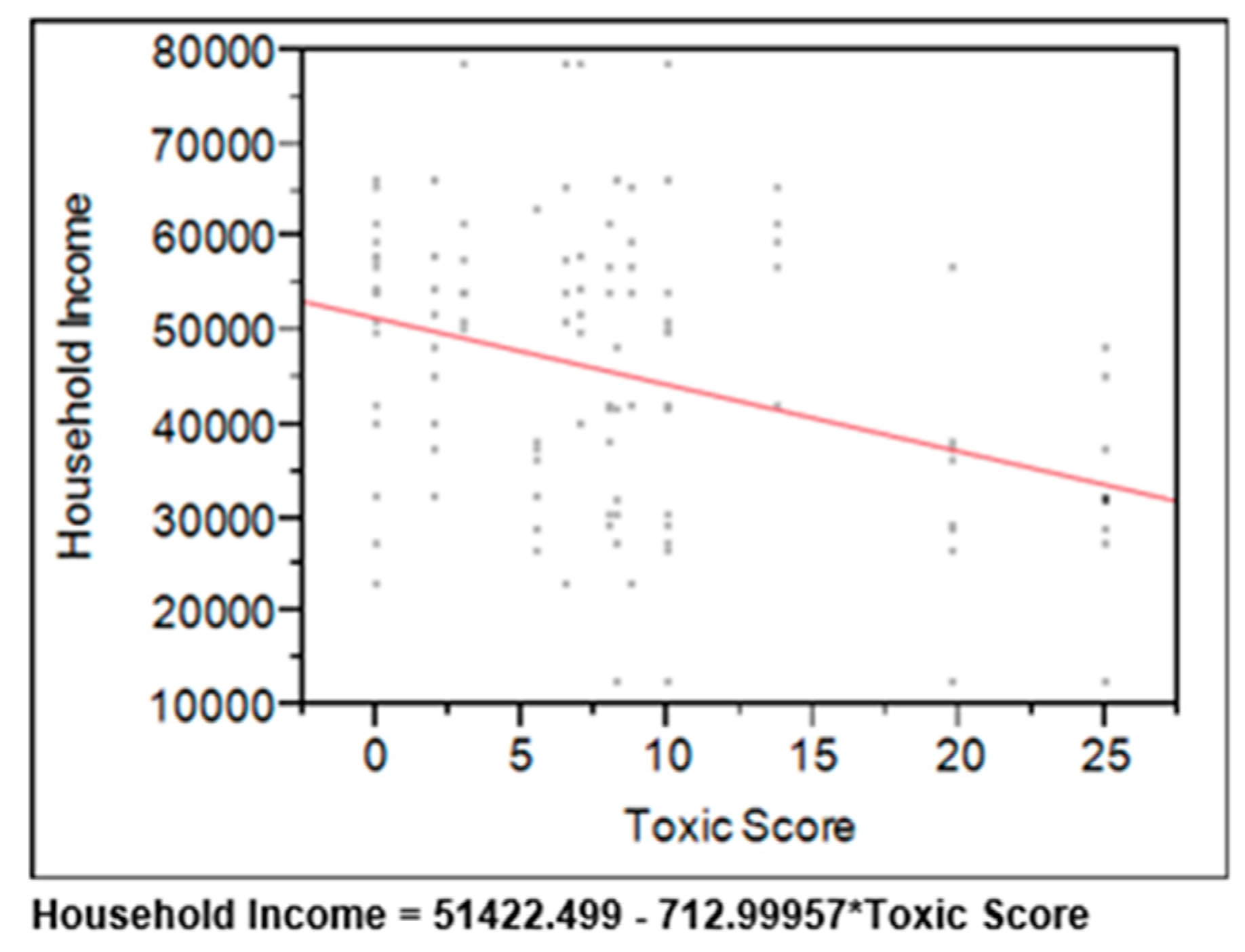
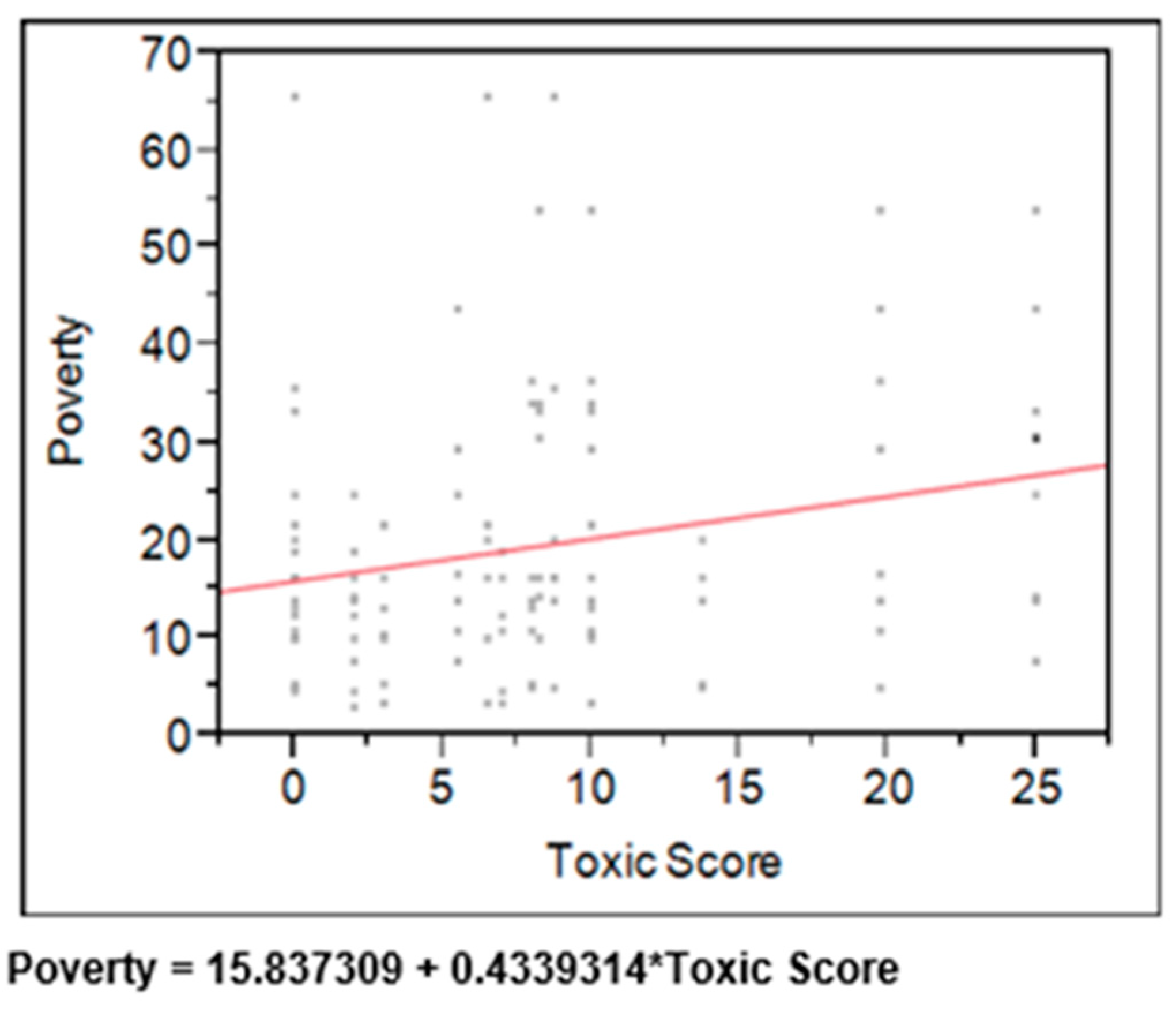

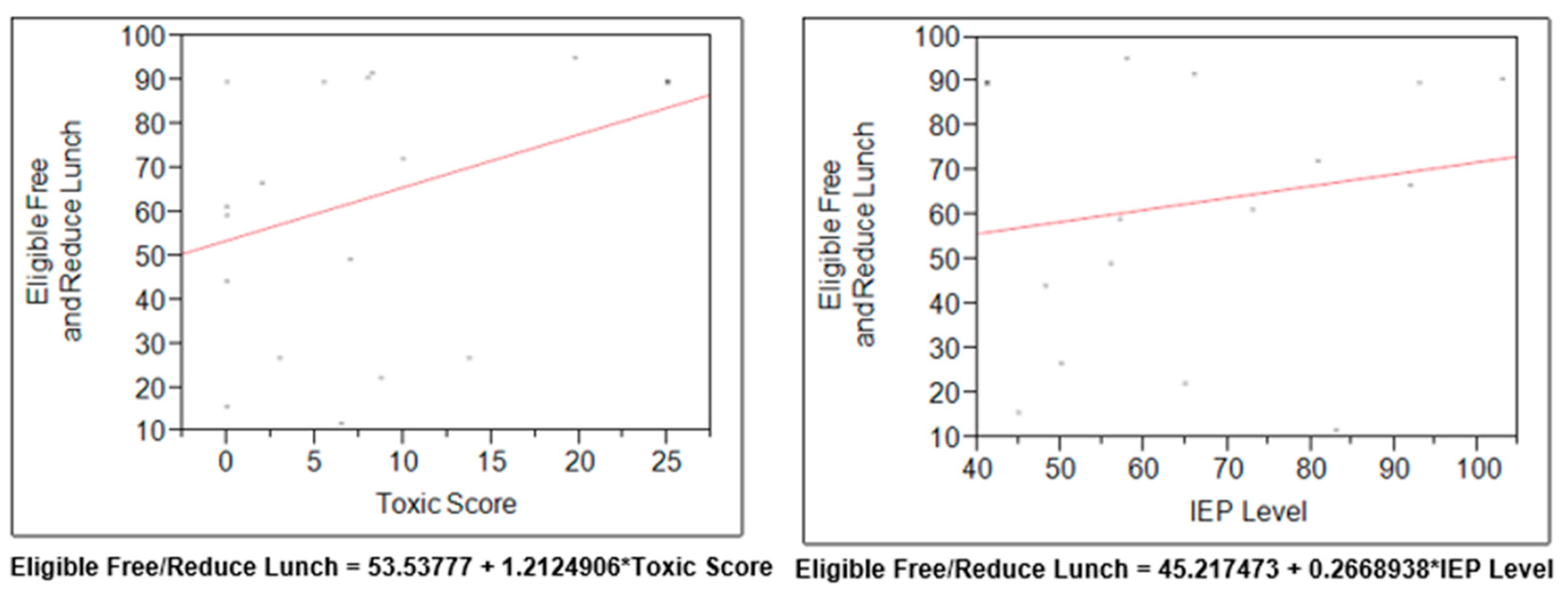



| Metals (WF = 1), | PAH (WF = 0.5) | Solvents (WF = 0.25) |
|---|---|---|
| Antimony, Arsenic, Barium, Beryllium, Cadmium, Chromium, Cobalt, Copper, Lead, Mercury, Nickel, Selenium | (124-Trimethylbenzene), (135-Trimethylbenzene), Acenaphthylene, Benzene, Benzo(a)anthracene, Benzo(a)pyrene, Benzo(b)fluoranthene, Benzo(ghi)perylene, Benzo(k)fluoranthene, Chrysene, Cumene, Dibenzo(ah)anthracene, Diesel, Ethylbenzene, Fluoranthene, Fluorene, Gasoline, Indenol(123cd) pyrene, Phenanthrene, Polychlorinated Biphenyls, TEH-D, TEH-WO, Xylene, n-Propyl benzene, Arochlor1260 | (111trichlorothane) anthracene, 2butanone, Acetone, Bromomethane, Methylene chloride, TCE, TPH, Tetrachloroethylene, Trichloroethene, cis12-dichloroethylene, Toluene |
| School (coded) | City | School Type | # Sites (in district) | Toxics Score | IEP # | % Minority | % Multi-race | % Taking Free or Reduced Lunch | % Eligible free or reduced lunch |
|---|---|---|---|---|---|---|---|---|---|
| W1 | W | E | 5 | 19.75 | 58 | 79 | 9 | 88 | 95 |
| W2 | W | E | 4 | 10 | 81 | 38 | 11 | 67 | 72 |
| W3 | W | E | 1 | 5.5 | 93 | 61 | 9 | 85 | 90 |
| W4 | W | E | 2 | 8.25 | 66 | 65 | 13 | 89 | 91 |
| W5 | W | E | 0 | 0 | 48 | 18 | 8 | 44 | 44 |
| W6 | W | E | 1 | 2 | 92 | 37 | 10 | 54 | 66 |
| W7 | W | E | 3 | 8 | 103 | 67 | 11 | 85 | 90 |
| W8 | W | E | 0 | 0 | 57 | 39 | 5 | 59 | 59 |
| W9 | W | E | 4 | 25 | 41 | 55 | 14 | 89 | 89 |
| W10 | W | E | 2 | 7 | 56 | 18 | 10 | 46 | 49 |
| W11 | W | E | 0 | 0 | 73 | 11 | 10 | 61 | 61 |
| CF1 | CF | E | 2 | 3 | 50 | 12 | 7 | 27 | 27 |
| CF2 | CF | E | 1 | 6.5 | 83 | 11 | 5 | 10 | 12 |
| CF3 | CF | E | 0 | 0 | 41 | 9 | 6 | 23 | 24 |
| CF4 | CF | E | 3 | 8.75 | 65 | 13 | 3 | 22 | 22 |
| CF5 | CF | E | 3 | 13.75 | 50 | 5 | 6 | 36 | 38 |
| CF6 | CF | E | 0 | 0 | 45 | 13 | 3 | 15 | 15 |
| CF7 | CF | M | 6 | 22.5 | 79 | 12 | 5 | 22 | 22 |
| CF8 | CF | M | 3 | 9.5 | 77 | 12 | 5 | 20 | 20 |
| W12 | W | M | 4 | 23 | 74 | 23 | 6 | 63 | 63 |
| W13 | W | M | 10 | 30.5 | 99 | 55 | 9 | 86 | 86 |
| W14 | W | M | 6 | 17 | 102 | 73 | 8 | 91 | 91 |
| W15 | W | M | 3 | 9 | 87 | 25 | 5 | 50 | 50 |
| W16 | W | HS | 7 | 23.25 | 229 | 47 | 6 | 62 | 62 |
| W17 | W | HS | 15 | 65.25 | 247 | 37 | 5 | 55 | 55 |
| CF9 | CF | HS | 9 | 32 | 122 | 13 | 4 | 19 | 19 |
| Source | DF | Sum of Squares | Mean Square | F Ratio |
|---|---|---|---|---|
| Model | 1 | 30838.389 | 30838.4 | 23.7027 |
| Error | 24 | 31225.149 | 1301.0 | Prob > F |
| C. Total | 25 | 62063.538 | <0.0001* |
| Demographics | RSq | Mean of Response | F Ratio | p-value |
|---|---|---|---|---|
| Age (0 to 9) and Toxic Score | 0.064 | 12.48 | 8.10 | 0.0052 |
| White Population and Toxic Score | 0.13 | 264.66 | 18.32 | <0.0001 |
| Black Population and Toxic Score | 0.07 | 117.73 | 9.03 | 0.0032 |
| Black Population and IEP Level | 0.24 | 117.73 | 37.70 | <0.0001 |
| Household Income and Toxic Score | 0.11 | 45725.99 | 14.96 | 0.0002 |
| Poverty and Toxic Score | 0.045 | 19.30 | 5.53 | 0.0203 |
| No Degree and Toxic Score | 0.19 | 11.75 | 28.29 | <0.0001 |
| High School and Toxic Score | 0.109 | 32.56 | 14.33 | 0.0002 |
| Bachelor and Toxic Score | 0.19 | 16.35 | 28.52 | <0.0001 |
| Postgraduate and Toxic Score | 0.15 | 8.69 | 21.64 | <0.0001 |
| Eligible Free or Reduced Program and Toxic Score | 0.08 | 63.22 | 11.068 | 0.0012 |
| Eligible Free or Reduced Program and IEP Level | 0.03 | 63.22 | 4.24 | 0.0416 |
Disclaimer/Publisher’s Note: The statements, opinions and data contained in all publications are solely those of the individual author(s) and contributor(s) and not of MDPI and/or the editor(s). MDPI and/or the editor(s) disclaim responsibility for any injury to people or property resulting from any ideas, methods, instructions or products referred to in the content. |
© 2023 by the authors. Licensee MDPI, Basel, Switzerland. This article is an open access article distributed under the terms and conditions of the Creative Commons Attribution (CC BY) license (http://creativecommons.org/licenses/by/4.0/).





